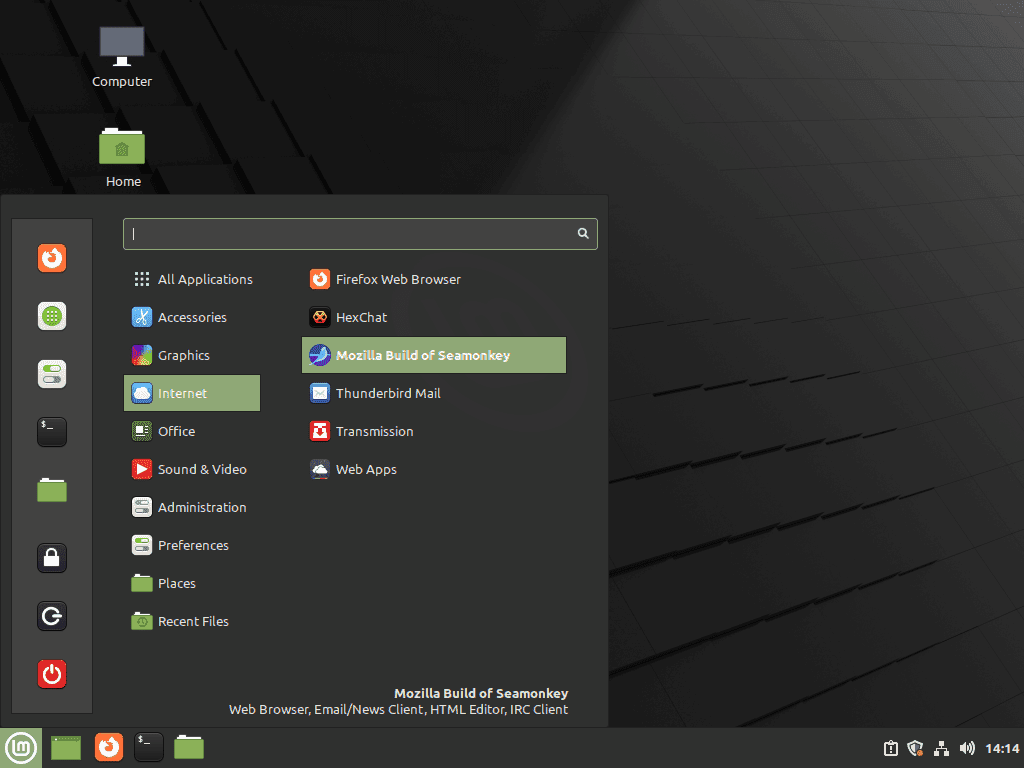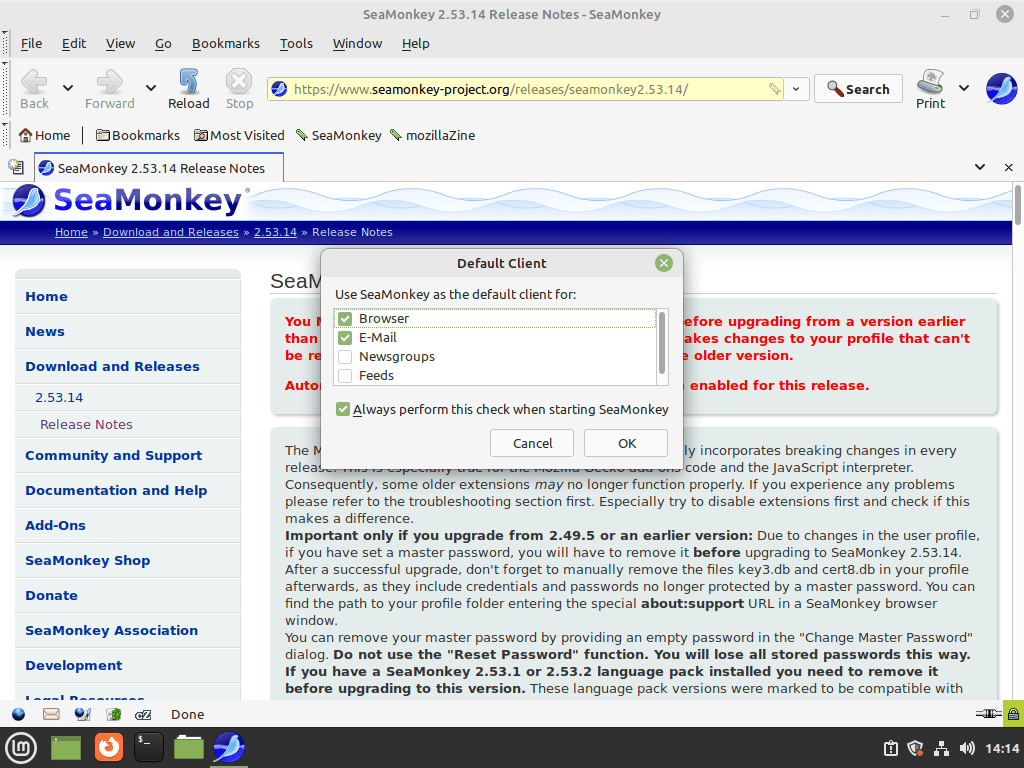SeaMonkey is an all-in-one internet suite that combines web browsing, email, IRC chat, and web development tools into one cohesive application. Built on Mozilla’s trusted technology, it replaces the need for separate Firefox, Thunderbird, and IRC clients by integrating everything into a unified interface with shared settings and profiles. If you want to install SeaMonkey on Linux Mint, this guide walks you through every step.
This guide shows you how to add the Ubuntuzilla repository with proper GPG key verification, install the seamonkey-mozilla-build package through APT, launch SeaMonkey from terminal or GUI, configure first-time setup for browser and email, and maintain updates alongside your system packages. Whether you’re managing a home server that needs integrated web and email access, developing HTML content without switching between applications, or simply prefer Mozilla’s classic all-in-one design, SeaMonkey delivers a practical alternative to managing multiple standalone tools.
Check if SeaMonkey Is Already Installed
Before you add new repositories or install supporting packages, confirm whether SeaMonkey already exists on your system. Start by running the binary directly:
seamonkey --versionIf you see version output, you only need to keep the application updated with APT. When the command is missing, double-check through APT to be sure the package is not already present:
apt list --installed seamonkey-mozilla-buildOnly proceed with the repository steps when both commands report that SeaMonkey is absent.
Update Your System and Install Dependencies
Update Your System Packages
Before proceeding, start by updating your system to ensure all installed packages are current. Open the terminal and run:
sudo apt update && sudo apt upgradeThis command refreshes your package list and installs the latest updates.
Install Repository Management Tools
Next, install the packages needed for secure repository management:
sudo apt install dirmngr software-properties-common apt-transport-https -yUnderstanding APT Repository Management
If you’re new to adding third-party repositories on Linux Mint, think of it as teaching your system where to find software beyond the default sources. While Linux Mint ships with curated repositories containing tested packages, specialized applications like SeaMonkey require adding their own sources.
The process involves three key steps:
- GPG Key Import: Verifies package authenticity and prevents tampered downloads from reaching your system.
- Repository Addition: Tells APT where to find SeaMonkey packages on the internet.
- Package List Update: Refreshes available software from the new source so APT knows what’s installable.
Ultimately, this workflow ensures you get legitimate SeaMonkey builds while maintaining your system’s security model. In this case, the Ubuntuzilla repository provides Mozilla applications compiled specifically for Debian-based distributions like Linux Mint.
Add the SeaMonkey Repository
Initialize the GPG System
First, initialize the GPG system if this is your first time using it:
sudo gpg --list-keysImport the Repository GPG Key
Next, import the GPG key to verify package authenticity:
sudo gpg --no-default-keyring --keyring /usr/share/keyrings/ubuntuzilla.gpg --keyserver keyserver.ubuntu.com --recv-keys 2667CA5CExample output:
joshua@linux-mint:~$ sudo gpg --no-default-keyring --keyring /usr/share/keyrings/ubuntuzilla.gpg --keyserver keyserver.ubuntu.com --recv-keys 2667CA5C gpg: keybox '/usr/share/keyrings/ubuntuzilla.gpg' created gpg: key B7B9C16F2667CA5C: public key "Daniel Folkinshteyn (Ubuntuzilla signing key) <nanotube@users.sourceforge.net>" imported gpg: Total number processed: 1 gpg: imported: 1
Add the Repository to Your Sources
After importing the key, add the Ubuntuzilla repository:
printf 'deb [signed-by=/usr/share/keyrings/ubuntuzilla.gpg] https://downloads.sourceforge.net/project/ubuntuzilla/mozilla/apt all main\n' | sudo tee /etc/apt/sources.list.d/ubuntuzilla.listRefresh Package Lists
Finally, update your package lists to include the new repository:
sudo apt updateInstall SeaMonkey
Install the Package
Now, install the SeaMonkey package:
sudo apt install seamonkey-mozilla-buildVerify Installation
After installation completes, check the installed version:
apt list --installed seamonkey-mozilla-buildLaunch SeaMonkey
Terminal Method
Launch from the command line:
seamonkeyGUI Method
Search for “SeaMonkey” in your application menu and click the icon to launch.


Configure SeaMonkey Components
After launching SeaMonkey for the first time, you’ll see a setup wizard that helps configure the suite’s components. Here’s what to expect for each application:
Browser Setup
The browser opens by default with Mozilla’s start page. To customize, set your home page by navigating to Edit → Preferences → Navigator → Home Page. Additionally, you can import bookmarks from Firefox or Chromium using File → Import, though the import filter works best with Firefox’s native format. The browser uses the same Gecko rendering engine as Firefox but with a classic toolbar layout reminiscent of early Mozilla Suite.
Email Client Configuration
To set up email, navigate to Window → Mail & Newsgroups or press Ctrl+2. Once opened, the Account Wizard prompts you for your email address, incoming server (IMAP or POP3), and outgoing server (SMTP). Most modern providers like Gmail or ProtonMail require app-specific passwords rather than your regular account password. Therefore, enable SSL/TLS encryption in Edit → Account Settings → Server Settings for secure connections. The email client supports multiple accounts and integrates newsgroup subscriptions in the same interface.
IRC Chat Client
Access the IRC client through Window → IRC Chat or press Ctrl+3. Once launched, the ChatZilla interface connects you to IRC networks like Libera.Chat or OFTC. Enter a server address (irc.libera.chat) and choose a nickname. Then, join channels with /join #channelname. The chat client supports multiple servers, private messages, and logging, all within the same SeaMonkey window.
HTML Composer
The built-in HTML editor launches via Window → Composer or Ctrl+4. It provides WYSIWYG editing for quick web page creation without opening a dedicated IDE. While limited compared to modern editors, Composer handles basic HTML, CSS, and JavaScript for simple static pages or email templates. When finished, save files with File → Save and preview in the browser with File → Browse Page.
Profile and Backup
SeaMonkey stores all settings, bookmarks, emails, and IRC logs in ~/.mozilla/seamonkey/. Therefore, back up this directory regularly if you rely on SeaMonkey for email or important bookmarks. Alternatively, you can migrate profiles between systems by copying the entire directory to another Linux installation’s home folder.
Update SeaMonkey
To keep SeaMonkey current, update it alongside your system packages:
sudo apt update && sudo apt upgradeAlternatively, update only SeaMonkey:
sudo apt install --only-upgrade seamonkey-mozilla-buildRemove SeaMonkey
Uninstall the Package
To uninstall, remove the application:
sudo apt remove seamonkey-mozilla-buildAlternatively, remove with system configuration files:
sudo apt purge seamonkey-mozilla-buildRemove User Data
If needed, delete your user profile, bookmarks, and email:
rm -rf ~/.mozilla/seamonkey/This step permanently deletes your SeaMonkey user data, including bookmarks and saved emails. Ensure you back up any important information before proceeding.
Remove the Ubuntuzilla Repository
Once SeaMonkey is gone, delete the Ubuntuzilla repository entry and key so routine updates stop querying SourceForge:
sudo rm /etc/apt/sources.list.d/ubuntuzilla.list
sudo rm /usr/share/keyrings/ubuntuzilla.gpg
sudo apt updateThis keeps sudo apt update output clean and prevents 404 errors. Recreate the files later if you decide to reinstall SeaMonkey.
Clean Up Dependencies
Finally, remove unused packages:
sudo apt autoremoveTroubleshooting Common Issues
GPG Key Import Fails
If you see “gpg: keyserver receive failed” errors, first ensure dirmngr is installed:
sudo apt install dirmngrAlternatively, if keyserver.ubuntu.com is unreachable, use an alternative keyserver:
sudo gpg --no-default-keyring --keyring /usr/share/keyrings/ubuntuzilla.gpg --keyserver keys.openpgp.org --recv-keys 2667CA5CRepository Not Found or 404 Errors
First, verify the repository was added correctly:
cat /etc/apt/sources.list.d/ubuntuzilla.listThe Ubuntuzilla repository is hosted on SourceForge and occasionally experiences downtime. Therefore, if you receive persistent 404 errors, wait a few hours and try sudo apt update again. Meanwhile, check SourceForge’s status or the SeaMonkey project forums for maintenance announcements.
APT Update Errors After Adding Repository
First, ensure the GPG key was imported successfully and the repository URL is correct. If needed, remove and re-add the repository:
sudo rm /etc/apt/sources.list.d/ubuntuzilla.list
sudo apt updateAfterwards, repeat the repository setup steps from the beginning.
SeaMonkey Won’t Launch
First, run SeaMonkey from the terminal to see error messages:
seamonkeyIf you see missing library errors, then update your system:
sudo apt update && sudo apt upgradeSetup Wizard Won’t Complete
First, check that the profile directory has correct permissions:
ls -ld ~/.mozilla/seamonkey/If needed, fix permissions:
chmod 700 ~/.mozilla/seamonkey/Alternatively, create a fresh profile by backing up the existing directory:
mv ~/.mozilla/seamonkey ~/.mozilla/seamonkey.backupThen relaunch SeaMonkey to generate a new profile.
Email Account Authentication Errors
Modern email providers like Gmail, Outlook, and ProtonMail require app-specific passwords instead of your regular account password. Visit your provider’s security settings to generate an app password, then use that in SeaMonkey’s account setup.
Gmail server settings:
- Incoming (IMAP):
imap.gmail.comport 993 with SSL - Outgoing (SMTP):
smtp.gmail.comport 465 or 587 with TLS
Migrating Firefox or Thunderbird Profiles
SeaMonkey can’t directly import Firefox or Thunderbird profiles due to format differences.
Export Bookmarks from Firefox
In Firefox, navigate to Bookmarks → Manage Bookmarks → Import and Backup → Export Bookmarks to HTML. After exporting, import in SeaMonkey via Bookmarks → Manage Bookmarks → File → Import.
Export Email from Thunderbird
First, install the ImportExportTools NG extension in Thunderbird to export mail as EML files. Once exported, import them into SeaMonkey’s Mail client via Tools → Import.
Conclusion
SeaMonkey delivers Mozilla’s classic all-in-one philosophy to Linux Mint, integrating web browsing, email management, IRC chat, and HTML editing in a single cohesive application. By adding the Ubuntuzilla repository with proper GPG key verification, installing the seamonkey-mozilla-build package through APT, and configuring browser, email, and chat components during first-time setup, you now have a unified internet suite that eliminates managing separate Firefox, Thunderbird, and IRC tools. Ultimately, this streamlined approach particularly benefits minimal installations where reducing application sprawl improves efficiency, development workflows requiring rapid HTML prototyping alongside browsing, and environments where shared profiles simplify backups and system management.
Resources and Further Reading
Here are some useful resources to help you explore and get the most out of SeaMonkey on Linux Mint:

